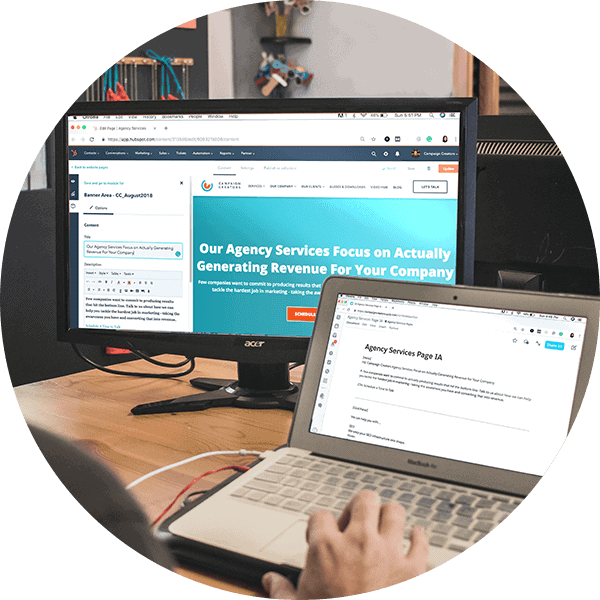
What Makes an Ad Work? Insights from Testing Ad Design on LinkedIn & Google
July 14, 2025When companies bring me in for help with their CRM, something’s usually already gone wrong.
What Can Go Wrong with Your CRM?
Legacy CRM Chaos
Sometimes they’ve been using a platform for years, but the CRM data is a disaster, and no one on the sales team has kept up with it. Then Marketing tries to use the data to run campaigns, but sales can’t give them anything useful. Other times, a team is still in the decision phase, trying to figure out which tools they should use. And sometimes, I’m brought in because a company has never used a CRM at all. They’ve been living in spreadsheets and have finally hit the point where that just isn’t working anymore.
Lack of a Documented Sales Process
One of the biggest red flags I hear is, “We don’t want to mess up what sales is doing, so we’re hesitant to make changes.” But when I dig in, it turns out no one actually knows what sales is doing. There’s no documented process. Each rep has their own system. There’s no accountability, no consistency, and no way to improve performance because nobody is measuring anything the same way.
Sales & Marketing Misalignment
Another early warning sign? Marketing and sales have never talked through lead handoffs. There’s no agreement on what a sales-qualified lead is, when a lead should be passed over, or what should happen after that. And without those definitions in place, automation doesn’t work, reporting is unreliable, and everyone’s flying blind.
CRM Rollouts Fail Before They Even Begin
CRM implementation fails all the time, not because of the platform, but because expectations weren’t set. Before a rollout ever happens, leadership needs to be crystal clear about what they expect from their teams. What should reps be logging? How often is data reviewed? What defines success? They also need to make sure the team understands that this isn’t about micromanaging. It’s about saving time, converting more leads, and getting clarity on what’s working and what’s not.
Everyone Gets Excited About the Shiny Stuff
Teams get excited about features. Sales loves the idea of automated sequences and removing repetitive tasks. Marketing loves the thought of pulling all their channels into one place. Social media, blogging, Google Ads, and email campaigns are all under one roof. Everyone loves the idea of lead scoring and segmentation.
But none of those features matter if the foundation isn’t solid. You can’t automate chaos. And you definitely can’t build trust between teams if everyone is working from a different rulebook.
Your CRM Needs Maintenance (Constantly)
Unfortunately I’ve seen each of these scenarios play out. Too many companies treat their CRM implementation and management like a one-time project. It’s not. Your CRM needs regular maintenance. If you’re not cleaning it up and reviewing usage, it’s going to fall apart.
I’ve seen databases with hundreds of junk contacts. People who were never going to buy, with no job titles, no company names, no usable information at all. Just because someone downloaded a PDF doesn’t mean they should be in your pipeline. You need to qualify contacts and be honest about their value to your business. Otherwise, you’re just creating noise. Poor data creates a vicious cycle:
If sales isn’t logging outcomes, marketing has no way to prove their efforts are working. The loop never closes, and budgets get cut because no one can connect the dots.
If Leadership Doesn’t Own It, the Teams Won’t Either
When CRM adoption goes smoothly, it’s because leadership steps in early and takes ownership. They bring the team into the process, ask for input, and build the rollout around how people actually work. I’ve seen companies do this well, and it makes a huge difference.
But I’ve also had to step in and play referee between sales and marketing. There’s often a breakdown in trust. Sales is treated like the revenue engine, so they’re allowed to do whatever they want, even when it undercuts the rest of the business. Marketing is stuck trying to measure and report on results with incomplete or unreliable data. Nobody wins in that situation.
Sales Reps Don’t Need More Work, They Need Context
I hear it all the time from reps: “I don’t want to learn another system,” or “This feels like you’re just trying to track everything I do.” That’s not the point, and it’s important to explain that upfront.
A good CRM should support the sales team, not slow them down. It should help them identify better leads, follow up faster, and close more deals. I always explain that it’s not just about tracking. It’s about making smart decisions based on real data. It’s about building a system that’s strong enough to outlast the rep. If you get hit by a truck tomorrow (yeah, I go there), someone else should be able to step in and give your accounts the same level of service. That’s how you protect the customer experience.
Stop Blaming the Platform, Fix the Process First
I’ve seen companies switch CRMs multiple times, thinking a new platform will solve their problems. But if your internal habits haven’t changed, nothing’s going to get better. You’ll just end up with another expensive tool that no one uses.
Before you choose a CRM, or before you switch, take time to evaluate your processes:
- How do leads come in?
- What’s the handoff process?
- What needs to be tracked, and why?
Most teams never stop to answer those questions. They pick the CRM with the flashiest features and the highest price tag. Then they barely use 10 percent of it.
When I work with clients, we start with the basics. We build real processes first, then implement the CRM in phases. We make a priority list, and we roll things out in a way that doesn’t overwhelm the team. The goal is to support sales and marketing, not disrupt them.
Final Thoughts
If you’ve been blaming the platform, it might be time to take a step back and look at your process. A CRM can only support your team if it’s built on a clear structure with real accountability. The good news? You don’t have to overhaul everything overnight. Start by getting honest about where the gaps are and take small, intentional steps to fix them.
If you’re not sure where to begin, I wrote another piece that gets into what CRM adoption really looks like from a sales rep’s perspective, what works, what doesn’t, and how to actually get people to use the system the way it was meant to be used. You can read that here: Closing the CRM Adoption Gap: Inside Tips from a Sales Rep Who’s Been There
If your team is struggling with HubSpot, Salesforce, or just figuring out what comes next, reach out. At Waypost, we help companies put the right systems in place, but more importantly, we help make sure people actually use them. Contact us here and let’s talk through what’s going on behind the scenes.








